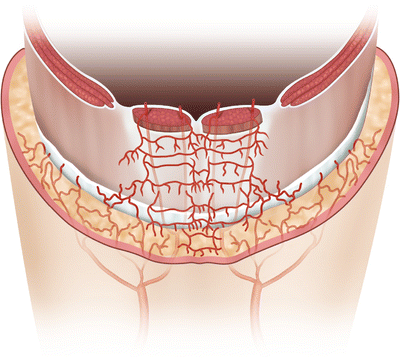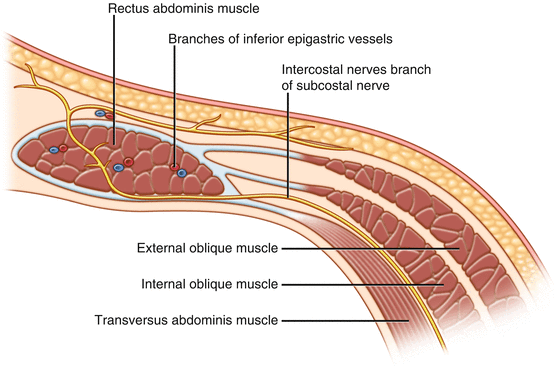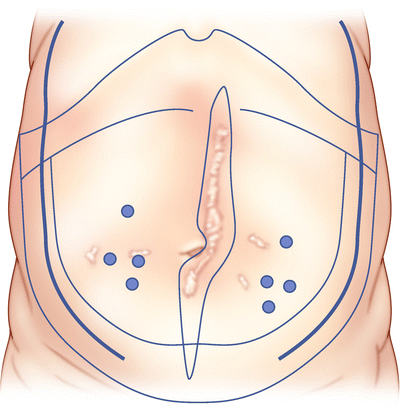Grade 1
Grade 2
Grade 3
Grade 4
Low risk
Comorbid
Potentially contaminated
Infected
• Low risk of complications
• Smoker
• Previous wound infection
• Infected mesh
• No history of wound infection
• Obese
• Stoma present
• Septic dehiscence
• Diabetic
• Violation of the gastrointestinal tract
• Immunosuppressed
• COPD
Anatomy
In order to plan a successful abdominal wall reconstruction (AWR), understanding the anatomy is critical. Failure rates of 30 % or more are routine. The better the surgeon understands the anatomy, the easier it is to plan an effective reconstruction.
Effective abdominal integrity requires an intact and compliant musculofascial layer. These muscles are the paired rectus abdominis, external oblique, internal oblique, and the transverse abdominis. Together with the fascial aponeuroses, these tissues create a supportive frame-up that maintains abdominal function. A disruption of the fascial support creates weakness that persistent abdominal pressure exploits (Fig. 8.1).


Fig. 8.1
Rectus abdominis, external, internal, and transverse abdominis anatomy
Understanding the orientation of the muscles is critical. The rectus abdominis is a paired, vertically oriented muscle covered by a strong fascial sheath. Two thirds down the muscle is the arcuate line. Above the arcuate line the anterior sheath consists of the entire external oblique fascia, and half of the internal oblique fascia. The posterior sheath is the other half of the internal oblique, the transversus abdominis fascia, and the transversalis fascia. However, below the arcuate line the posterior sheath consists of only transversalis fascia. This creates a potential weakness (Fig. 8.2).


Fig. 8.2
The rectus sheath
The linea alba is the fusion between the two rectus fascias. This structure is important in maintaining the structural integrity of the anterior abdominal wall.
The rectus muscle has a vigorous blood supply by the superior and inferior epigastric arteries. In addition supply is from the terminal branches of the intercostals. This blood supply allows the muscle to be used in many ways. Importantly, the skin above the muscle is supplied by these epigastric perforators (Fig. 8.3).


Fig. 8.3
Epigastric perforators. Note that they arise from the inferior and superior epigastric vessels close to the midline
Lateral to the rectus muscle is the linea semilunaris. This is the fascial attachment of the obliques to the rectus sheath. It too is an important landmark.
The obliques can be identified by the direction of the muscles. The external oblique is the largest of the muscles. Its fibers travel from lateral to inferior medial—like hands in pockets. The internal oblique travels from lateral to superior medial. While the transversus abdominis inserts directly transversely into the rectus sheath. The blood supply and nerves to these muscles travel between the internal oblique and the transversus (Fig. 8.4).


Fig. 8.4
Association of the nerves and vessels to the muscles
Operative Strategy
Rather than consider hernias as simple repairs, the term AWR gives greater understanding to the complexity of the process.
The goals are to prevent strangulation/incarceration, reestablish the linea alba, and create a functional myofascial abdominal wall.
The planning of repair of ventral hernias depends on a number of considerations. If the patient has been medically stabilized, a determination should be made of the timing of repairs. If the patient has a stable hernia, then planning the repair is significantly different than if there is contamination, bowel problems, or the loss of a functional protective abdominal wall. In this situation the initial goal is to use standard surgical processes to obtain a clean wound. Once this has been achieved then temporary coverage of the wound will allow stabilization of the patient and allow a definitive reconstruction at a later time. The urge to repair an unstable patient or unstable wound is bound to fail catastrophically. The idea should be to consider every repair as a staged elective process and maximize the preoperative preparation.
Operative Technique
Before undergoing surgical repair, it is important to understand mesh, its different types, and its indications.
Mesh
The technique of hernia repair has changed dramatically with the introduction of mesh. The improvement in repairs with these materials has changed the management of hernias.
However, there has been an explosion of devices and products. They can be conveniently divided into two categories: prosthetic meshes and bio-prosthetics. To understand hernia repair, it is important to get an understanding of the advantages and disadvantages of both.
There are multiple studies comparing these products; unfortunately, none thus far have provided much clarity as to any clear benefit of one product over another. Therefore, the surgeon is left to practice by trial and error.
Since 1950 polypropylene has probably been the most common synthetic material. It is inexpensive, lightweight, and has a monofilament structure that aids in incorporation and decreases the risk for infection. It is used to greatest advantage in the clean wound with good soft tissue coverage. It is incorporated into the tissue wall. This process has been improved with lighter weight mesh with a macroscopic pore structure. These changes improve compliance and incorporation. However, polypropylene is frowned upon in contaminated wounds. There also is a major concern about the possibility of bowel erosion and fistula formation.
In contrast (PTFE) (Gore-Tex) mesh was designed to prevent tissue adherence. However, this quality is also its largest problem. The absence of tissue adherence leads to poor incorporation of the material with high rates of failure which includes infection. In contrast to tissue incorporation, encapsulation prevents the mesh from providing adequate support with poor compliance matching and high rate of failure. For this reason, it is rarely used in typical situations.
Further developments and inventions have concentrated on the use of composite materials. These are a synthetic prosthetic covered with an absorbable membrane. These products have the theoretical advantage of nonabsorbable materials, and avoid the problems of adhesion to bowel, etc. However, there are no studies that demonstrate a significant advantage of one product over the other.
Polyglactin 910 mesh (vicryl) is a completely absorbable product that was another approach to solving the infectious potential of mesh. It is inert and 95 % absorbed by one month. It is mainly used in contaminated fields to provide temporary support until a definitive repair can be set up. Its use as a permanent solution is lacking because it is completely absorbed with a recurrence of the hernia defect.
In spite of the improvement in preventing hernia recurrences, the prosthetic meshes are still troubled by recurrences and a high rate of infection. The goal was to reproduce tissue that would mimic normal wall function and as well be incorporated into the native tissue. This is the field of bio-prosthetics. These compounds are designed to be re-vascularized and integrated like native tissue. These materials come from a variety of animal or human sources. They can be cross-linked for strength or not for better tissue ingrowth. There are three major types in practice: acellular porcine dermis, acellular human dermis, and porcine small intestinal submucosa. The theoretical advantage of these products is better tissue compliance and reduced risk of infection. However, the literature suggests that there is still a higher rate of recurrence with these bio-prosthetics. They are very costly, and depending on the degree of cross-linkage have a tendency to stretch. It is hard to justify their use in the straightforward case.
Technical Repair: Positioning and Marking
The patient is positioned in a supine position with arms abducted. A Foley catheter and a gastric tube are placed. All old incisions including excess skin and scars are marked (including old laparoscopic port sites and drain locations) and location of the skin perforators (Fig. 8.5).


Fig. 8.5
Marking extra skin, scars, and location of the perforators
Initial Operative Hernia Management
Incision
A full midline laparotomy incision is made, with an elliptical skin component to remove the old scar. The incision is stopped at the level of the pubis; generally do not extend the incision onto or below the pannus where skin care issues may compromise the incision*. Safe access to the abdominal cavity is critical to avoid bowel injury and is best achieved by opening the fascia in an area remote from the hernia (above or below the old incision). Avoid aggressive subcutaneous dissection around the periumbilical area in order to protect the skin perforators.
Stay updated, free articles. Join our Telegram channel

Full access? Get Clinical Tree








